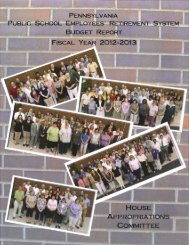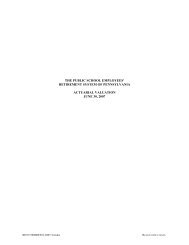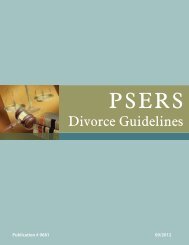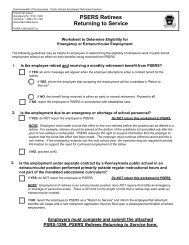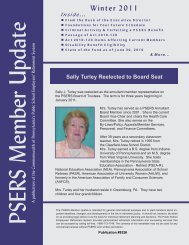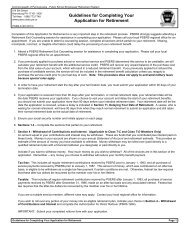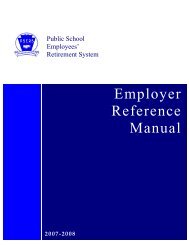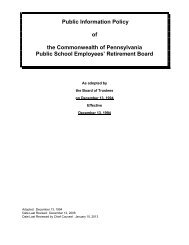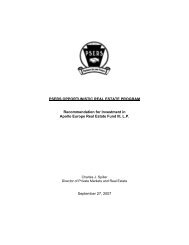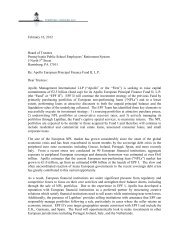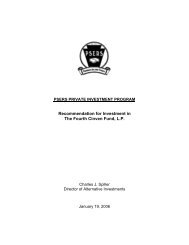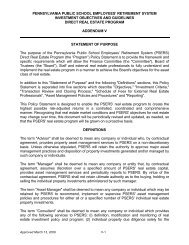a complete copy of the 2012 CAFR Report! - PSERs
a complete copy of the 2012 CAFR Report! - PSERs
a complete copy of the 2012 CAFR Report! - PSERs
You also want an ePaper? Increase the reach of your titles
YUMPU automatically turns print PDFs into web optimized ePapers that Google loves.
FINANCIAL SECTION<br />
Management’s Discussion and Analysis (continued)<br />
Investment Income<br />
Net investment income decreased from $9.2 billion in<br />
FY 2011 to $1.1 billion in FY <strong>2012</strong>, which is consistent<br />
with <strong>the</strong> decrease in <strong>the</strong> investment rate <strong>of</strong> return from<br />
20.37% for FY 2011 to 3.43% for FY <strong>2012</strong>. Net investment<br />
income changed by $3.1 billion from $6.1 billion in FY<br />
2010 to $9.2 billion in FY 2011, which is consistent with<br />
<strong>the</strong> increase in <strong>the</strong> investment rate <strong>of</strong> return from 14.59%<br />
for FY 2010 to 20.37% for FY 2011. As depicted in <strong>the</strong><br />
following chart, investment earnings provided 71% <strong>of</strong><br />
PSERS’ funding over <strong>the</strong> past 20 years. Net investment<br />
income also includes investment expenses as a deduction.<br />
The “Total PSERS’ Benefits and Expenses” section that<br />
follows includes an analysis <strong>of</strong> investment expenses.<br />
PSERS' Sources <strong>of</strong> Funding<br />
Twenty Year History (1993-<strong>2012</strong>)<br />
Investment<br />
Earnings<br />
71%<br />
Member<br />
Contributions<br />
15%<br />
Investment expenses decreased by $33.4 million from<br />
$514.7 million in FY 2011 to $481.3 million in FY <strong>2012</strong><br />
mainly due to a decline in management fees in <strong>the</strong> real estate<br />
and alternative investment asset classes. This reduction is<br />
widely attributable to changes in fee structure brought on<br />
by partnerships maturing. Also contributing to this change<br />
was a decrease in performance fees in <strong>the</strong> public market<br />
sector from FY 2011 to FY <strong>2012</strong>. Investment expenses<br />
decreased by $7.6 million from $522.3 million in FY 2010<br />
to $514.7 million in FY 2011 mainly due to a decline in<br />
management fees in <strong>the</strong> alternative investment asset class.<br />
This reduction is widely attributable to changes in fee<br />
structure brought on by partnerships maturing.<br />
Administrative expenses decreased by $1.2 million from<br />
$57.7 million during FY 2011 compared to $56.5 million<br />
during FY <strong>2012</strong> as PSERS continued to diligently control<br />
administrative expenses. FY <strong>2012</strong> and FY 2011 are more<br />
consistent with historical values. FY 2010 administrative<br />
expenses <strong>of</strong> $30.5 million were significantly lower due<br />
to a $23.8 million reduction from <strong>the</strong> capitalization<br />
<strong>of</strong> previously expensed GASB 51 qualifying costs for<br />
computer systems development.<br />
Employer<br />
Contributions<br />
14%<br />
Total PSERS' Benefits and Expenses<br />
Fiscal Year Ended June 30, <strong>2012</strong><br />
Total PSERS’ Benefits and Expenses<br />
The primary source <strong>of</strong> expense during FY <strong>2012</strong> was for<br />
<strong>the</strong> payment <strong>of</strong> benefits approximating $6.0 billion. The<br />
breakdown consisted <strong>of</strong> $5.7 billion for Pension, $97.0<br />
million for <strong>the</strong> PA program, and $213.0 million for HOP<br />
benefits. The chart at <strong>the</strong> end <strong>of</strong> this page illustrates <strong>the</strong><br />
significant portion <strong>of</strong> expenses attributable to benefit<br />
payments.<br />
Total PSERS’ benefit expense increased from $5.6 billion<br />
in FY 2011 to $6.0 billion in FY <strong>2012</strong>. The increase is<br />
attributable to higher lump sum payments as well as an<br />
ongoing increase to <strong>the</strong> average monthly benefit and an<br />
increase in <strong>the</strong> number <strong>of</strong> members receiving benefits.<br />
There was a decrease in fourth quarter retirements, in<br />
FY <strong>2012</strong> versus <strong>the</strong> same period in FY 2011, resultng in<br />
a lower pension benefits payable figure at June 30, <strong>2012</strong><br />
<strong>of</strong> $495.0 million compared to $646.4 million at June<br />
30, 2011. New retirements during FY <strong>2012</strong> outpaced <strong>the</strong><br />
number from FY 2011 by approximately 6%. Benefit<br />
expense increased from $5.3 billion in FY 2010 to $5.6<br />
billion in FY 2011. This increase is attributable to <strong>the</strong><br />
number <strong>of</strong> new retirements for <strong>the</strong> year, higher lump sum<br />
payments, as well as an ongoing increase to <strong>the</strong> average<br />
monthly benefit.<br />
PAGE 33<br />
Benefits<br />
91.7%<br />
Administrative<br />
expenses<br />
0.9%<br />
Investment<br />
expenses<br />
7.4%



